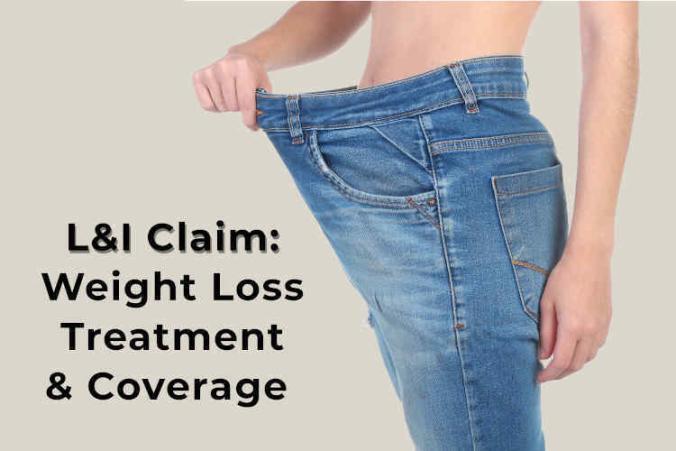The Department of Labor and Industries (L&I) covers medical treatment after a work injury or occupational disease. For treatment, L&I accepts certain conditions. Typically, L&I doesn’t cover conditions that do not relate to the workplace injury. However, in some cases, L&I allows temporary treatment of “unrelated conditions”. Specifically, when unrelated conditions prevent recovery from an accepted condition. In fact, L&I allows medical treatment of an unrelated condition as “aid-to-recovery”. Therefore, workers can sometimes receive treatment for obesity or being overweight. L&I considers this an unrelated condition.
L&I weight loss coverage
If you weigh too much, it can hold back your recovery after a work injury. For example, when your injuries involve weight-bearing muscles and joints. Explicit examples include foot injuries, ankles, knees, and hips. Additionally, excess weight can make it challenging to attend rehab treatments. Many times, overweight workers find it difficult to undergo physical therapy. Also, a diagnosis of obesity can delay surgery. This is until weight drops to appropriate levels. Hence, if obesity is a roadblock to recovery, then L&I may cover weight loss treatment.
Criteria for weight loss treatment
A worker must meet certain criteria for L&I to allow weight loss treatment. These criteria include:
1) The worker is “severely obese” with BMI of 35 or more.
2) Obesity is the main barrier to recovery. It’s preventing the worker from making progress on their L&I claim accepted conditions.
3) Weight loss is necessary to allow further treatment, surgery, physical rehabilitation, or returning to work.
How to get L&I pre-authorization for weight loss treatment
L&I requires several steps to pursue weight treatment coverage. First, the worker must request weight loss treatment. Here, L&I must pre-authorize the treatment. Otherwise, L&I will not pay for treatment expenses. To receive pre-authorization, your L&I doctor or attending provider needs to:
- Notify L&I or the self-insured employer of the worker’s weight and level of function before the injury. Also, your provider must explain how your weight impacts treatment and recovery.
- Describe the medical need for L&I obesity treatment. This includes tests, consultations, or diagnostic studies.
- If appropriate, your L&I doctor can request nutrition counseling. A Certified Dietician or Certified Registered Dietician Nutritionist are available.
Unfortunately, L&I won’t approve many popular weight loss methods. Specifically, L&I regularly denies coverage of:
- Weight loss surgery, drugs, or medication.
- Certain programs or special foods that include meals, supplements, and vitamins.
- Cookbooks and educational materials.
- Exercise programs and exercise equipment.
- Food scales and bathroom scales.
Developing a weight loss treatment plan
Next, L&I requires a plan before they can grant the pre-authorization. In state-funded claims, the L&I claim manager will draft a treatment authorization letter. This letter documents the terms of the plan. Work injury claimants must sign the authorization letter. This way, everyone agrees on the terms of the weight loss plan from the start. Therefore, work injury claimants and their providers must develop a treatment plan and specify:
a) How much weight the worker must lose.
b) Time estimate to complete the weight loss process.
c) The diet and exercise plan or the weight loss plan and methods.
d) The medical provider’s plan for monitoring progress.
e) Plans for documenting weekly weigh-ins.
f) Counseling and education from trained staff as appropriate.
Keeping the L&I authorization for weight loss active
L&I authorizes weight loss treatment in 90-day increments. However, work injury claimants must follow additional requirements to keep the authorization active. These requirements include:
i) Losing at least 5 pounds every 6 weeks.
ii) Attending weekly treatment sessions.
iii) Complying with the treatment plan.
iv) Checking in with the attending provider at least every 30 days.
v) Having the program coordinator sign a weekly weigh-in sheet.
vi) Sending the L&I claims manager the weekly weigh-in sheets.
It’s very important for the attending provider to see the worker every 30 days (or less). Also, the provider must notify the L&I claims manager if:
1) The work injury claimant reaches the weight goal.
2) Weight is no longer a barrier to treatment.
3) If the worker isn’t meeting their weight loss goals.
4) The work injury claimant isn’t cooperating with the treatment plan.
When will my L&I weight loss coverage end?
L&I coverage for weight loss treatment can end. One reasons for ending the coverage is when the work injury claimant reaches the weight goal. A second reason is if the worker’s obesity no longer impedes their recovery. Furthermore, another scenario is when the worker fails to drop the 5-pound minimum requirement over 6 weeks. Finally, L&I can end the treatment authorization if the worker isn’t cooperating with the plan.
Personally, I’ve seen good success with L&I weight loss treatments. Yet, the treatment is very bare-bones and basic. L&I uses mainstream programs, such as Weight Watchers or Noom. However, most plans come down to food modifications and calories deficits.
Concerns for workers receiving weight loss treatment
Due to work injuries, workers rarely take part in exercise programs. Although, walking exercises can be a successful and an integral part of L&I weight loss plans. Also, carefully designed strength training can be very beneficial.
In reality, the public nature of this L&I program can be frustrating to workers. Weight loss is often a very personal experience. Therefore, it can get extremely unpleasant having so many people monitoring your weight loss progress. Weekly weigh-ins can be stressful and demoralizing. Particularly, if the worker is having trouble meeting the mandatory weight loss goals.
Summary and conclusions
That said, L&I coverage for weight loss treatment is a huge benefit. Without it, excess weight can hinder recovery and stall the L&I claim indefinitely. Even worse, it can result in suspension of L&I benefits. In conclusion, there are some issues with these weight loss programs. However, they’re still an incredible benefit within the L&I claim process.

Leave a Reply